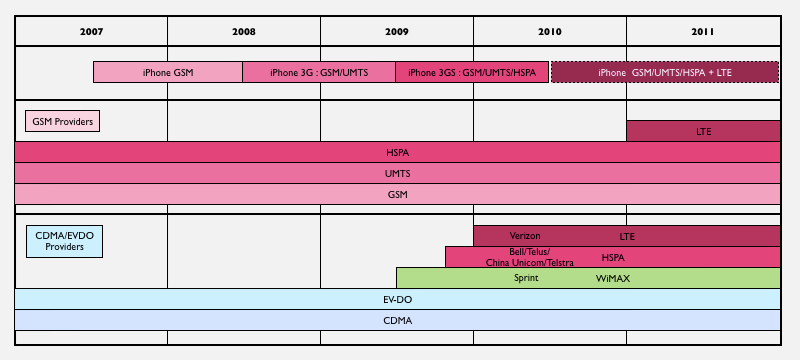Rogers Wireless, Apple's exclusive iPhone partner in Canada, is gaining new competition from its formerly CDMA-only rivals in a move that could foreshadow changes in the US market affecting AT&T and Verizon.
Apple originally launched the iPhone 3G in Canada exclusive to Rogers and its Fido subsidiary because the company was the only GSM/UMTS provider in the country. As with the US, Canada's mobile service providers are split between GSM and CDMA service, with Rogers/Fido playing the part of AT&T while the other two major providers, Bell and Telus, sell CDMA/EVDO service like Sprint and Verizon Wireless.
However, Bell and Telus are now rolling out a new HSPA (high speed packet access) 3G overlay that will enable both providers to sell the iPhone. HSPA is included in the 3GPP UMTS standard. Both Bell and Telus are adopting the new overlay as in interim step towards new LTE networks planned for deployment beginning sometime in 2011. Neither company will supply GSM/EDGE 2G service.
Bell is already listed by Apple as an iPhone mobile partner; Telus' new HSPA service is set to launch tomorrow. The new competition will provide an alternative to Roger's exclusive lock on the iPhone, which has been criticized for its unusually high prices and poor service.
CDMA/EVDO Migration to 3GPP
The move follows a global trend away from Qualcomm CDMA/EVDO networks. Last year, Australia's Telstra shut down its CDMA network in favor of exclusive UMTS service. Other providers, like China Unicom and Canada's Bell and Telus, have added UMTS service to their existing CDMA networks and plan continue to operate both until next generation LTE becomes a reality.
As other providers made similar moves toward 3GPP standards (which include UMTS/HSPA and LTE), Qualcomm decided to drop its efforts to introduce its own "Ultra Mobile Broadband" competitor and join the 3GPP in supporting LTE. That has left the remaining CDMA operators to decide between incrementally adding support for UMTS/HSPA or jumping directly to LTE.

In the US, Verizon has announced plans to begin deploying LTE beginning next year in addition to operating its existing CDMA/EVOD network, while Sprint is backing the unique WiMAX for its next generation data network.
After a series of carrier-exclusive iPhone introductions in most countries worldwide, Apple has demonstrated a desire to make its phone as broadly available on as many partners as possible; subscribers in Australia and Canada now have four or five options, thanks to carrier defections from CDMA.
As mobile providers all make the transition to today's UMTS/HSPA and tomorrow's LTE, Apple's ability to sell a single iPhone model globally will continue to expand.
The company's existing contract to exclusively sell the iPhone in the US with AT&T ends next year, opening the possibility of a new iPhone 3G/LTE model capable of working both on today's GSM/UMTS existing providers as well as CDMA providers now making the shift to LTE, such as Verizon in the US.


